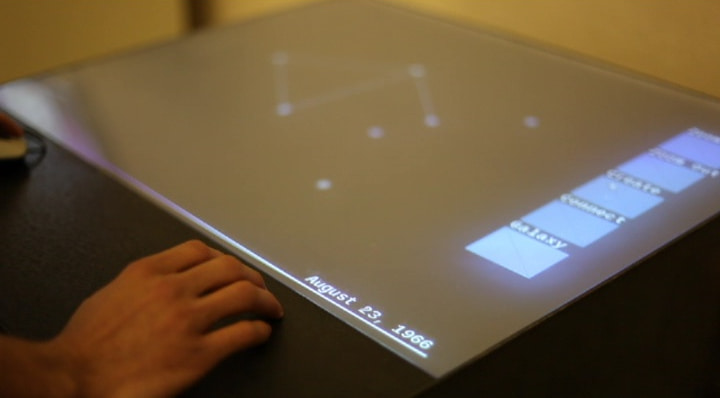28 May 2011
This post is part of a series describing the August 23, 1966 project.

The multi-touch table created for the project is a rear diffused illumination design, and is housed in a core‐ten steel cabinet with recessed cooling fans and an access panel on the rear vertical wall. The touch surface is a 1/2” polycarbonate sheet with an adhesive projection film applied to the underside (acting as a diffuser for the projected image).
Infrared light is projected at the diffuser from below (inside the cabinet) the touch surface. The table used an array of six multiple LED lamps. When an object touches the surface it reflects more light than the diffuser or objects far away from the surface. The change in light is detected by a webcam placed inside the cabinet, and the signal processed by our software as user input.
The multi-touch table used The Beta, from the NUI Group, to process the video stream from the webcam. The Beta, tbeta for short, is an open source tool that analyzes video to find tracking data for objects it recognizes as fingers or cursor devices. The software provides a great deal of control over the video parameters (high-pass filter, amplification, threshold, etc.) that adapts well to many types of multi-touch displays.
Tbeta outputs the tracking data using the TUIO protocol, which is an open framework for receiving input events in various programming environments. For this project, the TUIO events sent by tbeta were received using the open source Java TUIO library in a Processing sketch.
The Twoverse post includes some screenshots of the user interface displayed on the multi-touch table.
Despite careful calibration and testing in our workspace, the final move to the gallery threw the multi-touch table out of alignment and with the remaining time, we were unable to make it sufficiently responsive enough to user interaction. The distribution of IR light on the table’s surface was difficult to control, and hot spots had the habit of throwing the exposure of the webcam off and confusing Tbeta.
Although we used the surface as a display, gallery visitors had to use a traditional mouse to interact with the galaxy.
Continue to the next section, details of the Wiremap display.